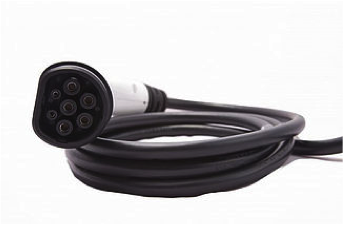AC EV Charging Connector Types For Electric Vehicle Charging Station?

A 5 Pin Connector
(J1772)

Type 1:
Reflecting the SAE J1772/2009 automotive plug specifications
The charging plug defined in 2009 is designed for the 120/240 volt single-phase three-wire network available in North America. Unlike the European Type 2 plug, the Type 1 plug is standardly not interlocked on the vehicle side (used for electrical safety and anti-theft) so that it can be removed at any time, even during charging and by unauthorized persons, thereby stopping the charging process becomes.
In America, the theft protection of the cable plays no role, since they are firmly connected to the charging station. In addition, some newer vehicle models may block the pinch lever of the Type1 connector as a kind of lock.
Despite the standardization, American and Asian electric vehicle models are still being sold in Europe with the vehicle-side Type1 connector, since the vehicles are mostly designed for the local power grid and therefore only a single-phase AC charger (230V, max 7.4 kW ) have installed. Since the charging cables typically have a Type 2 plug on the station side and a Type 1 plug on the vehicle side, adapters are not required and usually not approved.
The plug was designed for 10,000 mating cycles, so it should last at least 27 years in a daily plug-in cycle. It has a diameter of 43mm and has five contacts – two live contacts (outer conductor / neutral L1 and N), one protective conductor (PE) and two signal contacts (CP and PP). The signal contacts use the same protocol for communication with the charging station as with the Type 2 connector.

A 7 Pin Connector
(IEC 62196-2)

Type 2:
Reflecting the VDE-AR-E 2623-2-2 plug specifications
The European standard plug for charging modern electric vehicles is the so-called “Type 2 plug”, which is colloquially also called “Mennekes” plug after the company involved in the development. The term “type 2” comes from the corresponding standard IEC 62196-2, which defines three types of AC adapter (type 1 for single-phase charging, type 2 for 1- and 3-phase charging, type 3 for 1-phase and 3-phase 3-phase charge with shutter).
The vast majority of new AC charging stations in Europe have at least one Type 2 connection. This is unlike conventional household sockets (SchuKo) for permanently high currents (usually 32A / 400V or 22 kW) and designed in contrast to the already known red or blue CEE plugs to several thousand – as smooth as possible – plug-in operations. This feature is important for daily charging of electric vehicles. In addition, the plugs of high-quality cables are completely filled with plastic so that the plug will not be damaged even when driving over it.
The Type 2 plug can be locked at the station as well as at the vehicle to protect against pulling under voltage. This way charging can not be stopped by unauthorized persons and the cable can not be stolen.
All connectors of the standard have, in addition to the power conductors, additional pins for communication between the electric car and the charging station. This indicates which maximum charging power the cable used and the charging station support. The Charging station and electric car also signal each other’s current status (e.g., “ready to charge”). In the long term, this communication can be supplemented with a powerline connection to support additional services such as Internet access or SmartGrid functions.